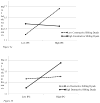Children's Vulnerability to Interparental Conflict: The Protective Role of Sibling Relationship Quality
- PMID: 29916198
- PMCID: PMC6301125
- DOI: 10.1111/cdev.13078
Children's Vulnerability to Interparental Conflict: The Protective Role of Sibling Relationship Quality
Abstract
This study tested whether the strength of the mediational pathway involving interparental conflict, adolescent emotional insecurity, and their psychological problems depended on the quality of their sibling relationships. Using a multimethod approach, 236 adolescents (Mage = 12.6 years) and their parents participated in three annual measurement occasions. Tests of moderated mediation revealed that indirect paths among interparental conflict, insecurity, and psychological problems were significant for teens with low, but not high, quality bonds with siblings. High-quality (i.e., strong) sibling relationships conferred protection by neutralizing interparental conflict as a precursor of increases in adolescent insecurity. Results did not vary as a function of the valence of sibling relationship properties, adolescent sex, or gender and age compositions of the dyad.
© 2018 Society for Research in Child Development.
Figures



Similar articles
-
The legacy of early insecurity histories in shaping adolescent adaptation to interparental conflict.Child Dev. 2014 Jan-Feb;85(1):338-54. doi: 10.1111/cdev.12119. Epub 2013 May 3. Child Dev. 2014. PMID: 23647368 Free PMC article.
-
Are there individual and sibling differences in appraisals of interparental conflict?J Fam Psychol. 2017 Oct;31(7):933-938. doi: 10.1037/fam0000326. Epub 2017 Apr 10. J Fam Psychol. 2017. PMID: 28394142
-
Children's attentional biases to emotions as sources of variability in their vulnerability to interparental conflict.Dev Psychol. 2020 Jul;56(7):1343-1359. doi: 10.1037/dev0000994. Epub 2020 Jun 1. Dev Psychol. 2020. PMID: 32478529 Free PMC article.
-
Annual Research Review: Interparental conflict and youth psychopathology: an evidence review and practice focused update.J Child Psychol Psychiatry. 2018 Apr;59(4):374-402. doi: 10.1111/jcpp.12893. J Child Psychol Psychiatry. 2018. PMID: 29574737 Review.
-
A systematic review and meta-analysis of the associations between interparental and sibling relationships: Positive or negative?PLoS One. 2021 Sep 28;16(9):e0257874. doi: 10.1371/journal.pone.0257874. eCollection 2021. PLoS One. 2021. PMID: 34582487 Free PMC article.
Cited by
-
Implications of COVID-19 school closures for sibling dynamics among U.S. Latinx children: A prospective, daily diary study.Dev Psychol. 2021 Oct;57(10):1708-1718. doi: 10.1037/dev0001196. Dev Psychol. 2021. PMID: 34807691 Free PMC article.
-
Supportive Neighborhoods, Family Resilience and Flourishing in Childhood and Adolescence.Children (Basel). 2022 Apr 1;9(4):495. doi: 10.3390/children9040495. Children (Basel). 2022. PMID: 35455539 Free PMC article.
-
Conflict Resolution and Emotional Expression in Sibling and Mother-Adolescent Dyads: Within-Family and Across-Context Similarities.J Early Adolesc. 2022 Feb;42(2):227-261. doi: 10.1177/02724316211020360. Epub 2021 Jun 1. J Early Adolesc. 2022. PMID: 35103031 Free PMC article.
-
Risk and Resilience Factors During the COVID-19 Pandemic: A Snapshot of the Experiences of Canadian Workers Early on in the Crisis.Front Psychol. 2020 Dec 3;11:580702. doi: 10.3389/fpsyg.2020.580702. eCollection 2020. Front Psychol. 2020. PMID: 33343455 Free PMC article.
-
On the risks of secure attachment in infancy: Childhood irritability and adolescent depression predicted by secure attachment and high approach behaviours at 14-months towards a caregiver living with inter-parental violence.Front Child Adolesc Psychiatry. 2023 Apr 17;2:1143125. doi: 10.3389/frcha.2023.1143125. eCollection 2023. Front Child Adolesc Psychiatry. 2023. PMID: 39839586 Free PMC article.
References
-
- Achenbach TM. Manual for the Child Behavior Checklist: 4–18 and 1991 Profile. Burlington, VT: University of Vermont Department of Psychiatry; 1991.
-
- Aiken LS, West SG, Reno RR. Multiple regression: Testing and interpreting interactions. Newbury Park, CA: Sage; 1991.
-
- Arbuckle JL. AMOS (Version 25.0) [Computer Program] Chicago: IBM SPSS; 2017.
Publication types
MeSH terms
Grants and funding
LinkOut - more resources
Full Text Sources
Other Literature Sources
Medical

